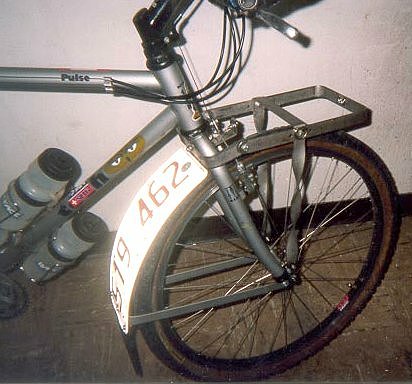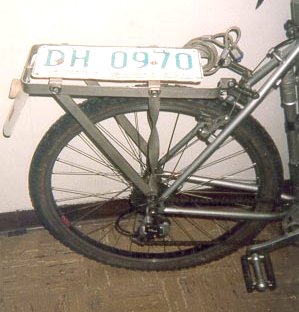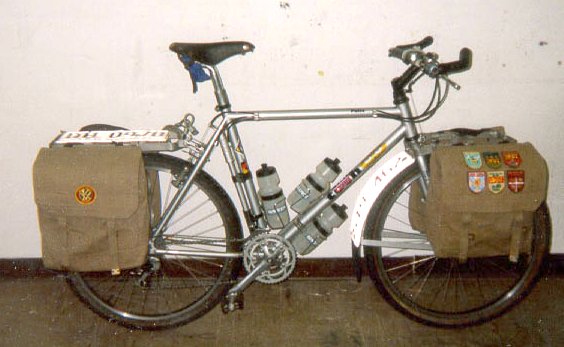| Bicycling Life |
About Our Site
Issues & Editorials
Solutions for Little
Problems,
Adjustments, and Repairs.
Using Bikes in Everyday
Life
Commuting & Errands
Cycling for Fun &
Health
Street Smarts for Bicyclists
Safety Issues
Advancing Cycling Issues
Getting Involved
Position Papers
Research and
Source Documents
|
| |
|
  Heavy
Duty Touring Racks Heavy
Duty Touring Racks
|
"If
You Want Something Done Right, You Have To Do It Yourself"
When I first began bicycle touring, I was pretty-well sold on the idea of an extremely
light, minimalist approach. I even shunned a sleeping bag, instead donning all my
cold-weather cycling clothes at night and rolling up in a sheet of 4-mil plastic
vapour-barrier. Many times I was up at 4 A.M., shivering and soaked in condensation,
forced to get on the bike and hammer down the road, in an effort to get warm. Obviously
this wasnıt a plan I couldıve continued long-term (a 'Spartan' existence is best
appreciated in small doses), so gradually I added bits and pieces for trips
farther-afield, when I was on the road for longer periods.
Presently I prefer long trips that are free from a 'city-to-city' mode of touring.
I enjoy the independence (not to mention the economy) of being able to pull off
anywhere for the night, and still be well-fed, warm, and comfortable. Iım no longer a
minimalist; I take what I need to be "at home" anywhere. This new approach has
not been free of problems, though.
On several of my tours in Asia and Australia I've been forced to carry up to 17 liters
of water, not to mention 3-4 day's food, fuel for my stove, camping gear, tools, spares
and all the rest, and I've yet to come across an aluminum rack that didn't break under the
strain. I've spoken to a lot of other cyclists who do similar tours, and they all have
disaster stories to relate: of time wasted looking for a welder, or of being marooned on
the side of a road or trail mending broken racks with splints and wire cut out of fences,
even wrapping spare spokes and twisting them, 'rebar' fashion, to keep the whole together
- honestly, what good is a manufacturer's guarantee, when you're stuck way-the-hell out in
the middle of nowhere? I've seen expensive panniers patched with duct tape or secured on
with shoelaces or inner-tubes, and once even a bound-and-knotted arrangement that utilized
a pair of XC-ski long underwear!
Those very up-market Gordon and Sakkit racks are out of my reach, price-wise; no point
in even thinking about them. The money I'd have to spend, including exchange, duty,
and shipping would keep me literally for months in India. I think it makes much more sense
to save the money, to invest in Goan beer.
So, to put an end to failures at the most inopportune time (as if there could ever be
an opportune one), and considering the implausibility of my owning those
beautifully-crafted tubular 'Cro-Moly' racks you Yanks make, I decided to cobble together
my own racks and panniers.
I no longer put any faith in aluminum as a material for racks, so I chose 1" x
1/8" '316' stainless-steel bar stock. I chose "316" Stainless Steel
because of its high Nickel and Chromium content, which makes it highly resistant to
corrosion. If I had to do it all over again, a choice of 3/4" rather than 1" x
1/8" flat bar stock would reduce the weight by 25%.
| However, I've no inclination to abandon what I've already made, since it
has proven itself to be up to the task. I realize this translates as heavy, and it is,
relative to the Blackburn's and Nagaoka's that I used-and-abused previously.
But the finished articles are fairly close to the published weights of the aluminum
Jandd racks, found in the Rivendell catalogue. |

As to exact measurement of the parts, I'm a little hesitant to put forward
a 'blueprint', since there are so many different bikes out there. I'm hoping the
value of my ideas will be in demonstrating that individuals can be far more successful at
coming up with their own solutions to a problem, and don't have to have their needs
defined and dictated to them by the bike industry
|
Grant Petersen of Rivendell
Bicycles has seen them, and commented that they resemble racks he's seen in Japan on
courier bikes, which were designed for up to 50 kilogram payloads - in fact I've pinched
an idea from an Indian bicycle manufacturer's racks, by putting a twist in my front's
single stays and in two of the rear's four stays, to stiffen them up
They're not completely rigid, however; I've found that a little 'give' is a good thing,
to absorb shocks - when expedition loads are mounted on a rock-solid rack, there's a risk
that shock energy will be expressed not only in rack failures, but also in bent or broken
bike frame eyelets and drop-outs; potentially a much more serious problem, if it were to
occur in an isolated area far from water. Aussie readers will recognize this concern....
The choice of common, easily-obtained material with which to build my racks was part of
my overall strategy to come up with equipment that was not only strong and dependable, but
simple in design and execution; the rationale being that by keeping it simple, repairs or
modifications in the future would also be simple, and which would reflect the reality of
the non-technical (or often non- existent) support that's available on tours in my
favorite places. This principle of simplicity is something I find conspicuously absent in
a lot of modern equipment, with it becoming more and more esoteric in design and
manufacture (possibly a market-driven development, rather than answering the needs of the
consumer), and therefore much more difficult to fix, when it does pack-it-in; not a
characteristic that makes one want to take kit like this too far from home...for my
purposes, 'low-tech' actually becomes 'high-tech'.
Does one really need welded racks? Well, I would've, had I used tubing rather than bar
stock. Tubing would've necessitated a greater amount of time, money, and labor, and I
would've been drifting farther away from my ideal of simplicity. And what if I welded
something up, and I found I'd made a mistake in the dimensions, or something? I'd be stuck
with scrap. Bar stock was the obvious choice: what could be simpler than bending and
drilling holes, and then bolting a rack together? If there were ever a problem with
dimensions, I could always drill another hole.
I used the following tools, which are found universally in any metalworking shop: a
bench-mounted vise; hacksaw; mill file; ball-pein hammer; center-punch; large Crescent
wrench or 'adjustable spanner' (for bending); scriber (a nail works); electric drill, and
drill bits (cobalt bits work best on stainless steel, but if you have a lot of time and
patience and go slow, and use cutting oil (and know how to sharpen drill bits), High Speed
Steel bits will be OK; and finally I used a chunk of 1 1/4" O.D. plumbing pipe to
radius the bends. A by-product of my front racks' bolted-together construction is the
simplicity of 'leveling' it on different bikes using spacers and pre-drilled holes, and
also in its ability to fold flat in the bottom of a bike box, when the bike is packaged up
to travel.
Both racks feature a lot of clearance to allow me to mount them on bikes with wheel
diameters larger than 26", and also to eliminate the interference problems
encountered when cycling in 'gumbo', when bicycle tires start to look like their
automotive counterparts. Australian 'bull-dust' is absolutely the WORST when it turns to
mud; it sticks like glue, and sets like concrete. Due to this problem I've also ceased
using ordinary fenders, which would quickly clog my wheels into immobility. Instead, I've
adapted found license-plates for the purpose which, being flat, are MUCH easier to clear:
"Tasmania/Holiday Isle" on the rear, and "Northern Territory/Outback
Australia" on the front. Hint: my pump is normally situated behind my seat-tube, but
when Iım cycling in the muck I store it in my tent-pole bag to prevent it from getting
similarly clogged.
My fenders are also guaranteed ice-breakers and conversation-starters: when people are
prompted to criticize them for the amount of air-resistance they must create, I get to
reply (tongue-in-cheek) that, "they're my built-in headwind, to help keep my speed
down".
I don't find low-rider-type racks suitable for my kind of touring, due partly to the
absence of a top platform - my front rack's platform provides a space on which to lay a
tent and allows extra water, carried in 2-liter pop bottles slung together, to be draped
over the top. And in Nepal, India, and Thailand I've cycled in water up to my hubs and
b/b, and through foot-deep or more ruts - either the resistance of flowing water against
low-rider-mounted panniers, or their contacting the ground would've made my bike
unrideable. I've come to the conclusion that low-rider-type racks are far-better suited to
the lesser rigors of road touring: the heavily-laden panniers expedition cyclists favor on
the front can damage even the beefy steel low-riders that Japanese cyclists use - not
solely from being overburdened, but because of the leverage panniers are able to exert on
a rack when they contact anything, to bend and eventually break it.
| Another thing: the platforms on most 'store-bought' racks are tiny, and
it's difficult sometimes to set them up so that shoe heels don't rub rear panniers, and
with all that must be piled on the bike there's soon a growing resemblance to a
'rubbish-heap'. My my rear rack has a platform of 7" x 17," which yields
almost twice the area of the Blackburn's 5"x 12," allowing ample space for
everything and still leaving room for heel clearance, working on brakes, and wheel truing.
|
 |
Regarding panniers: UV's really deteriorate nylon (noticeably so in Oz), and a lot of
the expensive stuff seems to rely on chintzy, light metal hook attachments or complicated
strapping, which only lasts while Velcro is new and dry. I decided to go with canvas after
seeing a bike with a pre-war Carradice saddlebag still in good shape. My panniers are
adapted from WW II Canadian army surplus, $10 each, and I re-inforced the seams with linen
thread (dental floss) at points of strain. The stiffeners are fashioned out of scrap
aluminum sheet with edges duct-taped, Kirtland-style, to prevent chaffing and then bolted
inside. These stiffeners eliminate any sagging of the panniers into the wheel, even with
the front rack's single stays. The hooks are 2" deep to lessen the chances of
panniers being 'bucked off', and are made of the same material as the racks. Shock-corded
S-hooks ensure my panniers stay put.

Canvas is a very durable material and even though it's cotton, proves to be remarkably
water-proof; the tightly-woven fibers expand with moisture and act as a seal. Even when
the outside appears sodden, inside there's often no sign of moisture at all. Patching is
easy, and if I were ever to damage a bag beyond repair, all I'd need to do is buy another
bag, and install my stiffener, hooks, etc. into it. It appears that all Commonwealth
countries share similar military equipment designs; I've seen the same bags for sale in
Australia, at "Aussie Disposals" surplus stores, and a Brit friend confirmed the
design was in use from WW I until well after WW II and is readily available in the UK.
Sheldon Brown
commented that with the loads I carry, I should consider using a trailer: I did consider a
"B.O.B." once, but I
concluded that pre- and post-tour travel by air or bus would become even more
complicated....
Even with four 2-liter pop/water bottles draped over both front and rear racks, I find
myself compensating naturally for sluggish steering when fully loaded. I don't share a
typical MTBer's speed and need for maneuverability on expeditions, and it's not an issue
when I'm on the road and have easy access to water: I simply discard the bottles and load
down accordingly. I don't always tour 'kitchen sink'-like; most tours I carry 30 to 35
pounds - somewhat less than many of the purely-road tourists I encounter. I just like to
have a large total capacity as an option that permits me the greatest leeway in choosing
routes, since I often hear locals say things like: "There's a prettier way to go, but
there's nothing out there at all...."
Paul Woloshansky
|
  |
|
|
